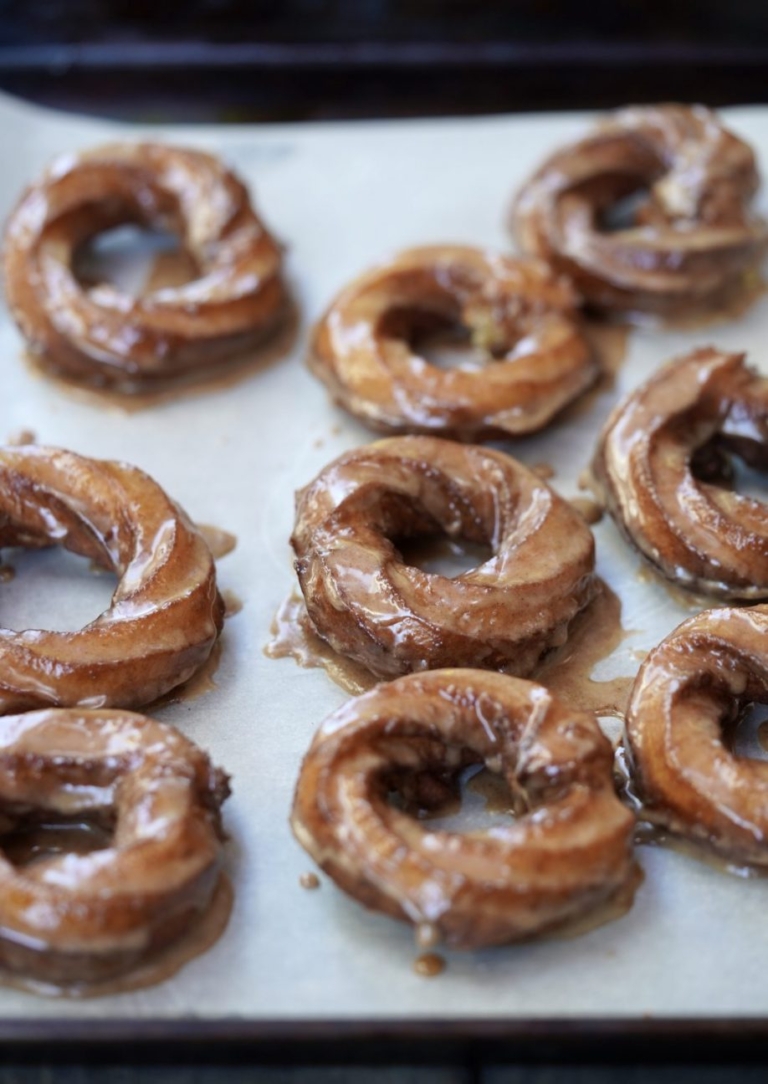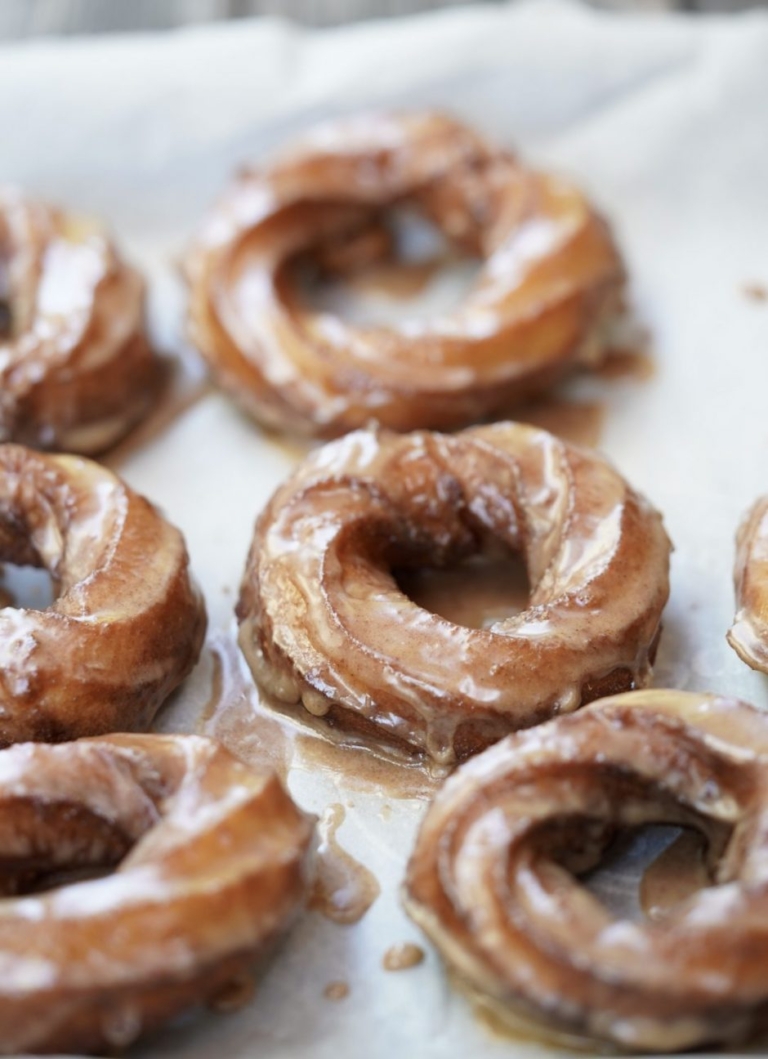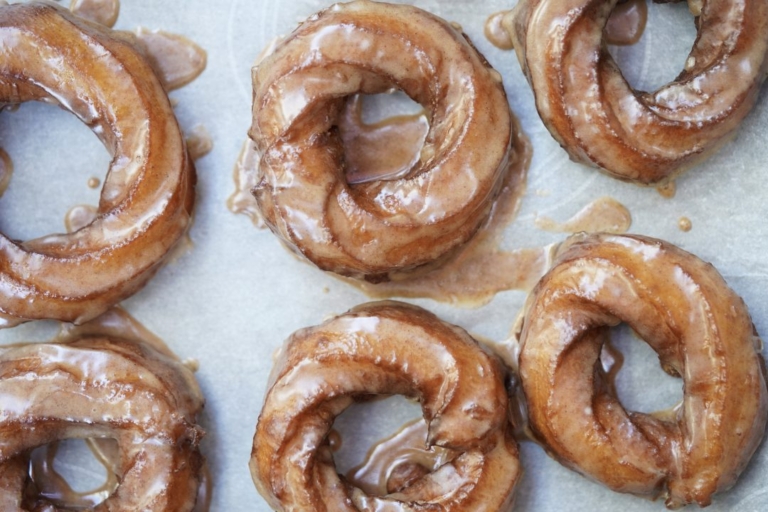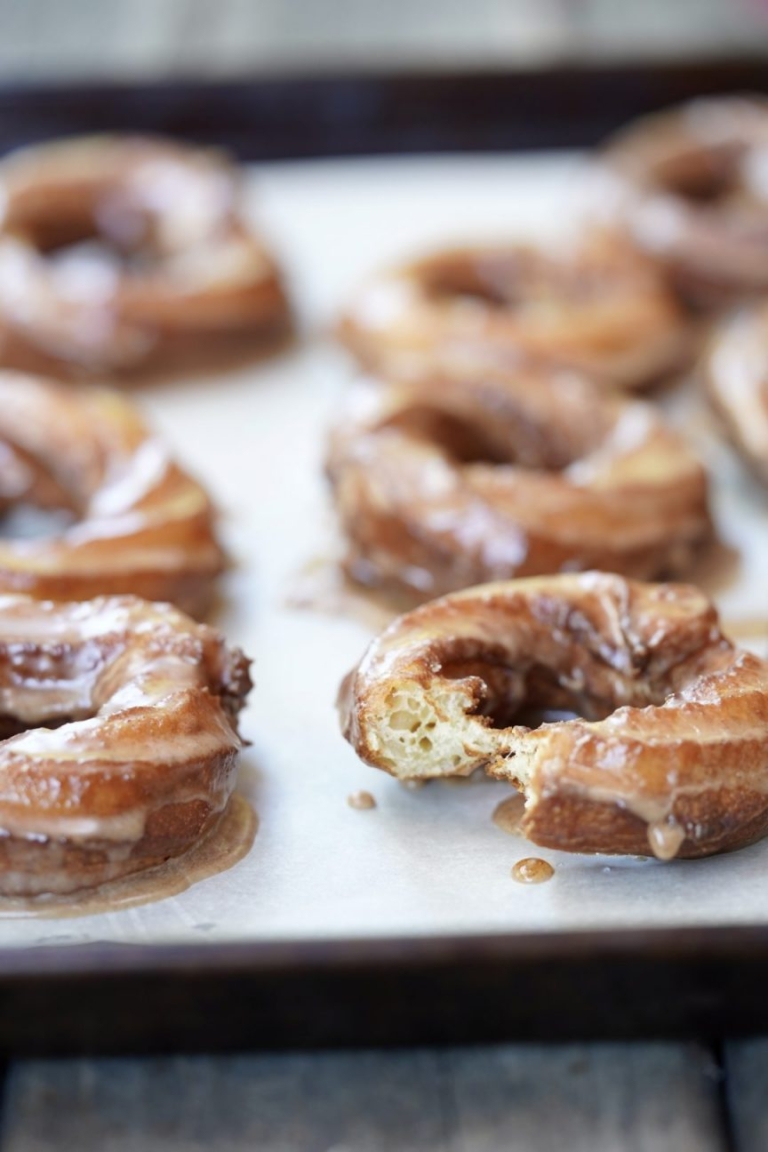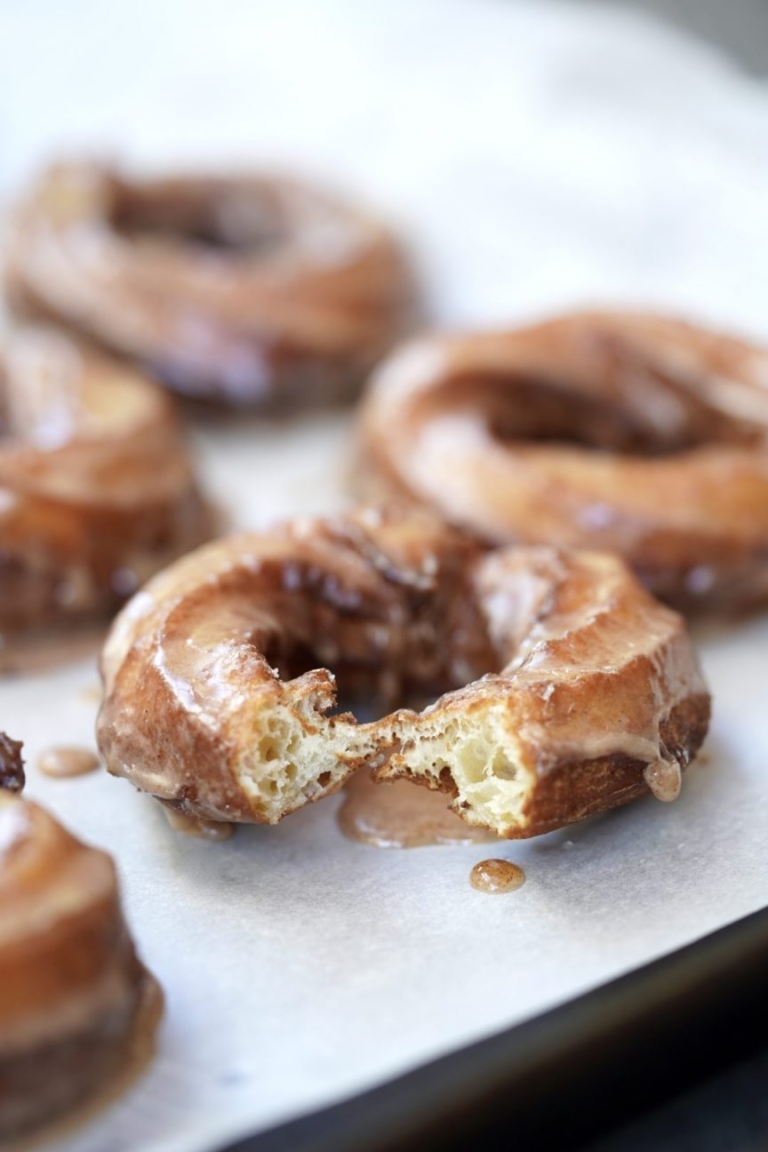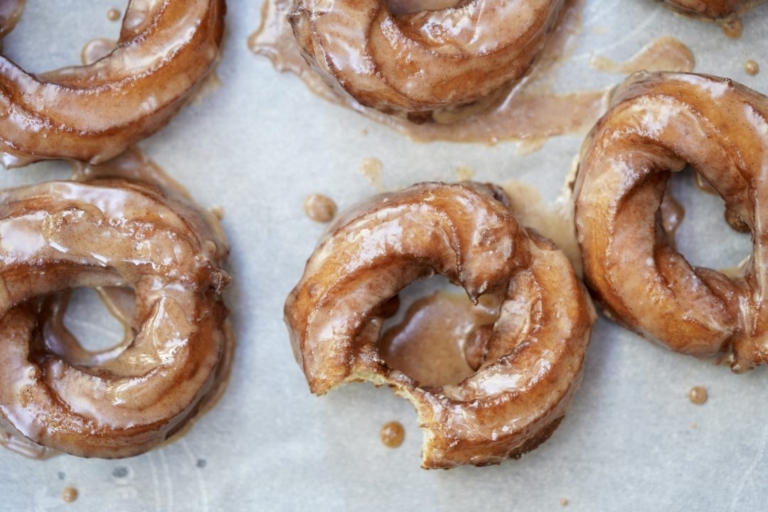Apple Cider Crullers With Cinnamon Glaze
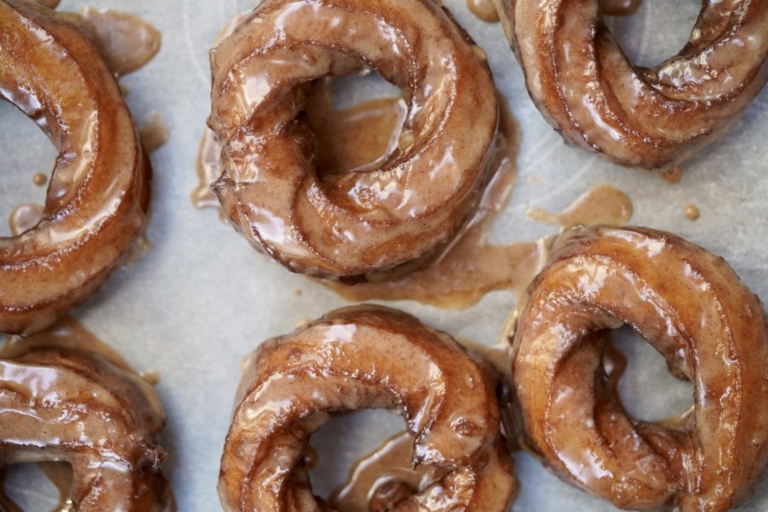
I love Fall. And with the exception of the holiday decorations coming out at way too fast of a clip, I enjoy all aspects of it. But personally, I think the pumpkin craziness gets a bit more glory than it deserves. Don’t get me wrong, I love a great pumpkin cookie, pumpkin muffins are my new go-to, pumpkin cheesecake is a yearly treat I look forward and pumpkin brownies can not be made often enough in my house. But, that said, all things apple should get equal, if not more, amounts of praise.
These are my homemade apple cider crullers with cinnamon glaze and they are completely addictive. Apples are a worthy fall fruit and I thoroughly enjoy baking with them. Apple tarte tatin has been a favorite go mine forever, apple strudel is a breakfast treat I could live on, apple butter is something I can eat with just a spoon and I’ll never say no to a Fallen Apple cocktail, even on a Tuesday. So let’s just set the record straight and say that autumn apples are just as wonderful as pumpkins.
I have blogged about my love of donuts before as they are a tradition in my house on anyones birthday but also on Hanukkah. When it comes to the donut world, I am select, and you know it as well as I do, all donuts are not equal. To eat them means they need to be worthy. These apple cider crullers are in fact just that, they are also addictive. Some donuts are baked and some, like these crullers, are fried. Donuts can be filled or unfilled, glazed, dusted in sugar or frosted. All methods and variations are completely acceptable, it really just depends on what you’re in the mood for.
Donuts in History
Until the early 1800s, homemade donuts (also written “doughnuts”) were yeast-risen and time-consuming to produce. Around the 1830’s chemical learners like pearlash, (a precursor to baking powder), became widely available and those quicker, chemically-raised cake donuts showed up in grocery stores across America. And by the early 1900s, donuts were a common snack across the country. World Wars I and II helped cement the donut as a “wholesome American creation“. And both the Salvation Army and Red Cross served donuts to the front lines. Apparently the servicewomen who served soldiers these sweet treats were known as “Donut Dollies“. After World War II ended, it was actually veterans who began opening some of the first donuts shops in the states. The American donut quickly went onto become known as a working-class breakfast and afternoon snack
Types of Donuts
- Yeast Donuts: The base dough, which typically contains flour, sugar, salt, yeast, water or milk, and sometimes eggs, butter or oil, is mixed or kneaded, and allowed to rise for several hours. It is then rolled, cut, and allowed to rise again before each pre-shaped ring is dropped gently into hot oil. The fried dough rings are characterized by a fluffy texture and thin, soft, golden crust.
- Cake Donuts: Unlike the yeasted donuts, the cake donut’s leavening agent is not yeast, but rather a chemical one, such as baking soda or baking powder. Because of this, the base mixture, a blend of flour, milk or water, salt, sugar, sometimes eggs, and either baking soda or baking powder, doesn’t require rise time, and can be mixed, shaped, and fried right away. Although typically prepared as a batter, cake donuts can also be prepared as a dough. Because cake donuts cook quickly, but they also absorb more oil than yeasted donuts. In comparison to a yeast donut, a cake donut is dense, with a crisp exterior.
- Jelly Donuts: Jelly donuts are typically made from yeasted dough that’s cut either into squares or rounds, and then filled after being fried. Strawberry and raspberry are the two most common jelly donuts flavor, but everything you can imagine is out there these days.
- Cream Donuts: A cream donuts is really just a cake or yeasted donuts filled with cream, which is really a a thickened pastry cream, but watch out, it can also be pudding which I don not like. Vanilla, chocolate, lemon, or coconut-flavored are common flavors.
- Old-Fashioned Donuts: This donuts is considered a cousin to the cake donut. These donuts rise with the help of a chemical leavener to make a batter or a dough. You fry an old-fashioned donut at a lower temperature which is what creates those distinct cracked edges.
- Cruller: A Dutch creation, the traditional cruller (also known as kruller) is made from a rectangle of yeasted dough that is slit in the middle so it can be twisted and folded upon itself and then fried. Like cake and yeasted doughnuts, the French cruller gets its rise from a mechanical leavening agent. With crullers the dough often, incorporates beaten eggs which, when cooked, puff and expand. When fried instead of baked, the batter retains its airiness and if piped into hot oil from a pastry bag fitted with a fluted tip, the finished product resembles a ridged ring.
- Long John: These old-timers are yeasted donuts cut into a rectangle. Its shape is traditional oblong. Some stores call them a rectangular fritter when filled and a Long John when unfilled. If glazed with a maple-frosting, a Long John becomes a maple bar.
As a kid, my dad would go get a big box of assorted donuts for breakfast Sunday morning when my sister and I visited. Even then I was not a huge breakfast person, but I loved donut morning. These apple cider crullers aren’t your traditional cruller, they are more a hybrid of a cruller and a cake donut, since those are my favorite type of donuts. You pipe these crullers was a pasty bag and fry them just a few minutes in oil to obtain that soft inside and crispy exterior. Topped with cinnamon glaze these donuts get my two teenage boys out of bed quickly when I make them and I think that right there says a lot!
Apple Cider Crullers With Cinnamon Glaze
Ingredients:
For the Crullers:
- 1 cup apple cider
- 1/2 cup unsalted butter
- 1 1/2 tablespoons brown sugar
- 1-2 cinnamon sticks
- 1 1/2 cups all-purpose flour
- Pinch of salt
- 1 1/2 teaspoons vanilla extract
- 3 eggs
- Canola or vegetable oil
For the Glaze:
- 1/2 teaspoon cinnamon
- 1 cup Confectioners' sugar
- Dash of vanilla extract
- 1 1/2-2 teaspoons cold water
Directions:
- For the Crullers: In a small saucepan add the apple cider, butter, brown sugar and cinnamon sticks, place over low medium heat and and bring to a boil. Reduce the heat to a simmer and cook for about 10-12 minutes until the liquid has reduced to about 1/4 cup of liquid. Remove from the heat, discard the cinnamon sticks, pour into a medium mixing bowl and let cool slightly.
- Once cool, add the flour, salt and vanilla and mix to incorporate. Add the eggs, one at a time and mix until incorporated. Transfer the batter to a pastry bag fitted with a 1/2-inch star tip. Set aside.
- In a medium pot add some oil, about 2-inches in depth. Heat on high until the oil reaches 350 degrees F on an instant read thermometer.
- While the oil is heating, line a baking sheet paper towel and set aside. Line a second sheet tray with parchment paper and set near your work station. Pipe out 6 rings, about 3 1/2-4 inches wide, onto the paper. Using scissors, cut out the parchment paper around the dough to separate the 6 crullers from each other.
- When the oil is hot, place one cruller at a time into the oil, paper side up. Carefully remove the paper with tongs. Fry the crullers for about 2-3 minutes on each side until golden brown. Carefully remove the cruller from the hot oil and place on the paper towel lined baking sheet to drain. Repeat the above process with the remaining 5 crullers.
- For the Glaze: In a small mixing bowl add the cinnamon, confectioners' sugar and water, a little at a time, and whisk until smooth. Drizzle the glaze over the warm crullers to coat. Serve right away.

